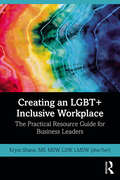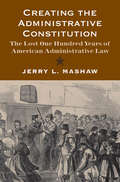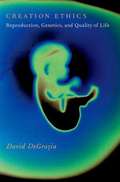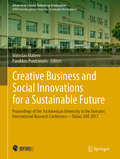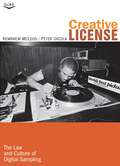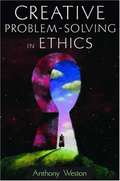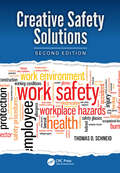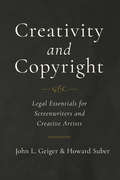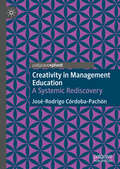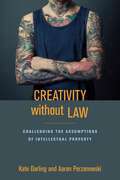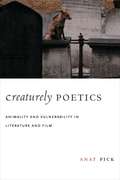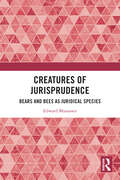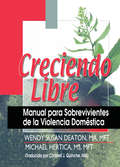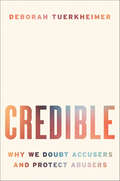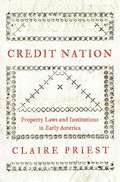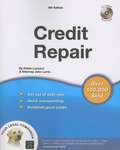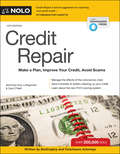- Table View
- List View
Creating an LGBT+ Inclusive Workplace: The Practical Resource Guide for Business Leaders
by Kryss ShaneSetting out best practices and professional guidance for creating LGBT+ inclusive workplaces, this approachable and easy to follow book guides current and future leaders of all industries toward appropriate and proven ways to create safer working environments, update company policies, enhance continuing education and training, and better support LGBT+ people in the workplace. Featuring real-life situations and scenarios, a glossary, and further resources, Creating an LGBT+ Inclusive Workplace enables professionals in all aspects of professional roles to integrate foundational concepts into their everyday interactions with staff at all levels as well as within the community to create an overall workplace culture that nurtures a welcoming, inclusive, and affirming environment for all. This book includes postcards from PostSecret as its foreword and more than a dozen exclusive interviews from the world’s top leaders in a variety of industries with world-renowned reputations. Enabling professionals in a variety of business roles to create an overall workplace culture that nurtures a welcoming, inclusive, and affirming environment for all, this book is an essential resource for independent readers, department teams, and entire corporations.
Creating the Administrative Constitution
by Jerry L. MashawThis groundbreaking book is the first to look at administration and administrative law in the earliest days of the American republic. Jerry Mashaw demonstrates that from the very beginning Congress delegated vast discretion to administrative officials and armed them with extrajudicial adjudicatory, rulemaking, and enforcement authority. The legislative and administrative practices of the U. S. Constitution’s first century created an administrative constitution hardly hinted at in its formal text. This book, in the author’s words, will "demonstrate that there has been no precipitous fall from a historical position of separation-of-powers grace to a position of compromise; there is not a new administrative constitution whose legitimacy should be understood as not only contestable but deeply problematic. "
Creating the Canon: Composition, Controversy, and the Authority of the New Testament
by Benjamin P. LairdDespite the profound influence of the New Testament, a variety of questions related to its background and history remain common. Contemporary readers often find the subject of the canon’s origin and formation to be complicated and confusing, while scholars continue to struggle to find agreement about basic elements of the canon’s development. In this engaging study, Benjamin P. Laird explores several misunderstood, disputed, and overlooked topics in order to provide fresh insight and clarity about the canon’s creation and modern relevance. The volume addresses questions such as: Was there a single “original autograph” of each New Testament writing? Who exactly were the “original readers” of the New Testament writings? Did theological controversies play a decisive role in prompting the canon’s formation? How did such a diverse body of writings come together to form a single canonical collection? Is there a basis for the canon’s ongoing authority? Wide-ranging yet accessible, Creating the Canon offers an illuminating treatment of the composition, formation, and authority of the New Testament and serves as a valuable guide to those with limited prior study.
Creation Ethics: Reproduction, Genetics, and Quality of Life
by David DegraziaThe ethics of creating-or declining to create-human beings has been addressed in several contexts: debates over abortion and embryo research; literature on "self-creation"; and discussions of procreative rights and responsibilities, genetic engineering, and future generations. Here, for the first time, is a sustained, scholarly analysis of all of these issues-a discussion combining breadth of topics with philosophical depth, imagination with current scientific understanding, argumentative rigor with accessibility. The overarching aim ofCreation Ethicsis to illuminate a broad array of issues connected with reproduction and genetics, through the lens of moral philosophy. With novel frameworks for understanding prenatal moral status and human identity, and exceptional fairness to those holding different views, David DeGrazia sheds new light on the ethics of abortion and embryo research, genetic enhancement and prenatal genetic interventions, procreation and parenting, and decisions that affect the quality of life of future generations. Along the way, he helpfully introduces personal identity theory and value theory as well as such complex topics as moral status, wrongful life, and the "nonidentity problem. " The results include a subjective account of human well-being, a standard for responsible procreation and parenting, and a theoretical bridge between consequentialist and nonconsequentialist ethical theories. The upshot is a synoptic, mostly liberal vision of the ethics of creating human beings. "This is a valuable book on a fascinating topic, written by a major figure in the field. The topic of the ethics of creating people is both practically urgent, as new technologies develop for shaping human offspring, and also of great theoretical importance for ethics and meta-ethics because it engages the deepest issues, including those of moral status, the nature of justice, and identity. DeGrazia has already proved to be an important force in shaping the debate regarding these issues. Anyone writing on this topic will have to address this book head-on. The style is remarkably lucid and almost jargon-free. Given that the book is filled with complex, sustained argumentation, this is quite an accomplishment. This book will be of interest to legal scholars, philosophers working in normative ethics, meta-ethics, and bioethics, and public policy scholars. " - Allen Buchanan, James B. Duke Professor of Philosophy, Duke University
Creative (Climate) Communications: Productive Pathways for Science, Policy and Society
by Maxwell BoykoffConversations about climate change at the science-policy interface and in our lives have been stuck for some time. This handbook integrates lessons from the social sciences and humanities to more effectively make connections through issues, people, and things that everyday citizens care about. Readers will come away with an enhanced understanding that there is no 'silver bullet' to communications about climate change; instead, a 'silver buckshot' approach is needed, where strategies effectively reach different audiences in different contexts. This tactic can then significantly improve efforts that seek meaningful, substantive, and sustained responses to contemporary climate challenges. It can also help to effectively recapture a common or middle ground on climate change in the public arena. Readers will come away with ideas on how to harness creativity to better understand what kinds of communications work where, when, why, and under what conditions in the twenty-first century.
Creative Autonomy, Copyright and Popular Music in Nigeria
by Mary W. GaniThis book provides an in-depth analysis of the unique structure of the Nigerian popular music industry. It explores the dissonance between copyright’s thematic support for creative autonomy and the practical ways in which the law allows singer-songwriters’ (performing authors') creative autonomy to be subverted in their contractual relationships with record labels. The book establishes the concept of creative autonomy for performing authors as a key criterion for sustainable economic development, and makes innovative legal and policy recommendations to help stakeholders preserve it.
Creative Business and Social Innovations for a Sustainable Future: Proceedings Of The 1st Aue International Research Conference - Dubai, Uae 2017 (Advances in Science, Technology & Innovation)
by Miroslav Mateev Panikkos PoutziourisThe book presents high-quality research papers presented at the 1st AUE International research conference, AUEIRC 2017, organized by the American University in the Emirates, Dubai, held on November 15th-16th, 2017. The book is broadly divided into three sections: Creative Business and Social Innovation, Creative Industries and Social Innovation, Education and Social Innovation. The areas covered under these sections are credit risk assessment and vector machine-based data analytics, entry mode choice for MNE, risk exposure, liquidity and bank performance, modern and traditional asset allocation models, bitcoin price volatility estimation models, digital currencies, cooperative classification system for credit scoring, trade-off between FDI, GDP and unemployment, sustainable management in the development of SMEs, smart art for smart cities, smart city services and quality of life, effective drivers of organizational agility, enterprise product management, DEA modeling with fuzzy uncertainty, optimization model for stochastic cooperative games, social media advertisement and marketing, social identification, brand image and customer satisfaction, social media and disaster management, corporate e-learning system, learning analytics, socially innovating international education, integration of applied linguistics and business communication in education, cognitive skills in multimedia, creative pedagogies in fashion design education, on-line summative assessment and academic performance, cloud concept and multimedia-based learning in higher education, hybrid alliances and security risks, industry and corporate security significance, legal regulation and governance. The papers in this book present high-quality original research work, findings and practical development experiences, and solutions for a sustainable future.
Creative Labour Regulation
by John Howe Sangheon Lee Deirdre Mccann Patrick Belser Colin Fenwick Malte LuebkerThe volume is at the forefront of the academic and policy debates on effective labour regulation, offering innovative approaches to research and policy. It is an interdisciplinary response to the central challenges that face modern labour regulation and draws on contributions by leading experts in a range of disciplines.
Creative License: The Law and Culture of Digital Sampling
by Kembrew Mcleod Peter DicolaHow did the Depression-era folk-song collector Alan Lomax end up with a songwriting credit on Jay-Z's song "Takeover"? Why doesn't Clyde Stubblefield, the primary drummer on James Brown recordings from the late 1960s such as "Funky Drummer" and "Cold Sweat," get paid for other musicians' frequent use of the beats he performed on those songs? The music industry's approach to digital sampling--the act of incorporating snippets of existing recordings into new ones--holds the answers. Exploring the complexities and contradictions in how samples are licensed, Kembrew McLeod and Peter DiCola interviewed more than 100 musicians, managers, lawyers, industry professionals, journalists, and scholars. Based on those interviews, Creative License puts digital sampling into historical, cultural, and legal context. It describes hip-hop during its sample-heavy golden age in the 1980s and early 1990s, the lawsuits that shaped U. S. copyright law on sampling, and the labyrinthine licensing process that musicians must now navigate. The authors argue that the current system for licensing samples is inefficient and limits creativity. For instance, by estimating the present-day licensing fees for the Beastie Boys' Paul's Boutique (1989) and Public Enemy's Fear of a Black Planet (1990), two albums from hip-hop's golden age, the authors show that neither album could be released commercially today. Observing that the same dynamics that create problems for remixers now reverberate throughout all culture industries, the authors conclude by examining ideas for reform. Interviewees include David Byrne, Cee Lo Green, George Clinton, De La Soul, DJ Premier, DJ Qbert, Eclectic Method, El-P, Girl Talk, Matmos, Mix Master Mike, Negativland, Public Enemy, RZA, Clyde Stubblefield, T. S. Monk.
Creative Problem-Solving In Ethics
by Anthony WestonA readable and insightful guide to ethical dilemmas.
Creative Safety Solutions (Occupational Safety And Health Guide Ser. #18)
by Thomas D SchneidIn today's rapidly changing workplace, safety and loss prevention professionals cannot always "go by the book" for the answers to new and unique problems and issues. When there is no tried-and-true solution to a problem, safety and loss prevention professionals must think outside of the box of conventional solutions and develop new and creative sol
Creativity and Copyright: Legal Essentials for Screenwriters and Creative Artists
by Howard Suber John L. GeigerInspired by Strunk & White's The Elements of Style, this elegant, short reference is the perfect guide for screenwriters and creative artists looking to succeed as industry professionals. Readers will quickly understand the laws that govern creativity, idea-making, and selling, and learn how to protect themselves and their works from the legal quagmires they may encounter. Written by an unrivaled pair of experts, John L. Geiger and Howard Suber, who use real-life case studies to cover topics such as clearance, contracts, collaboration, and infringement, Creativity and Copyright is poised to become an indispensable resource for beginners and experts alike.
Creativity and Cultural Production
by Phillip McintyrePhillip McIntyre brings a new understanding to the issues plaguing copyright industries as they struggle with the digital revolution. Applying research coming out of psychology, sociology, communication and cultural studies to look at television, radio, film, journalism, photography, popular music and new media, this groundbreaking book providesuseful insights to media practitioners as they go about their creative practice. Italso gives policy professionals concerned with creativity and innovation a solid research-based understanding of cultural production, andgoes well beyond common sense thinking about creativity, seeing it instead as a system in operation. In short, this bookwill change your mind about creativity. "
Creativity and Its Discontents: China’s Creative Industries and Intellectual Property Rights Offenses
by Laikwan PangCreativity and Its Discontents is a sharp critique of the intellectual property rights (IPR)-based creative economy, particularly as it is embraced or ignored in China. Laikwan Pang argues that the creative economy--in which creativity is an individual asset to be commodified and protected as property--is an intensification of Western modernity and capitalism at odds with key aspects of Chinese culture. Nevertheless, globalization has compelled China to undertake endeavors involving intellectual property rights. Pang examines China's IPR-compliant industries, as well as its numerous copyright violations. She describes how China promotes intellectual property rights in projects such as the development of cultural tourism in the World Heritage city of Lijiang, the transformation of Hong Kong cinema, and the cultural branding of Beijing. Meanwhile, copyright infringement proliferates, angering international trade organizations. Pang argues that piracy and counterfeiting embody the intimate connection between creativity and copying. She points to the lack of copyright protections for Japanese anime as the motor of China's dynamic anime culture. Theorizing the relationship between knockoffs and appropriation art, Pang offers an incisive interpretation of China's flourishing art scene. Creativity and Its Discontents is a refreshing rejoinder to uncritical celebrations of the creative economy.
Creativity in Management Education: A Systemic Rediscovery
by José-Rodrigo Córdoba-PachónThis book proposes a new way to consider creativity in management education, inviting educators to rediscover themselves in the process. To date, creativity in management is a valuable skill, but one which has been institutionalized and subordinated to metrics such as economic growth, knowledge disciplining and employability. After a critical analysis using Foucault’s governmentality to identify how creativity is being organized in management education, this book examines diverse initiatives intended to nurture creativity. Then, and through a systemic recontextualization of governmentality and other notions like play, it provides conceptual and practical guidance derived from the author’s own self-narratives (games) as student and educator. The book concludes with important reflections, implications and guidelines for the nurturing in creativity in management education and life in general. This book will be a valuable reading for creativity and innovation scholars, academics working in management education and students in general.
Creativity without Law: Challenging the Assumptions of Intellectual Property
by Kate Darling Aaron PerzonowskiBehind the scenes of the many artists and innovators flourishing beyond the bounds of intellectual property laws Intellectual property law, or IP law, is based on certain assumptions about creative behavior. The case for regulation assumes that creators have a fundamental legal right to prevent copying, and without this right they will under-invest in new work. But this premise fails to fully capture the reality of creative production. It ignores the range of powerful non-economic motivations that compel creativity, and it overlooks the capacity of creative industries for self-governance and innovative social and market responses to appropriation. This book reveals the on-the-ground practices of a range of creators and innovators. In doing so, it challenges intellectual property orthodoxy by showing that incentives for creative production often exist in the absence of, or in disregard for, formal legal protections. Instead, these communities rely on evolving social norms and market responses—sensitive to their particular cultural, competitive, and technological circumstances—to ensure creative incentives. From tattoo artists to medical researchers, Nigerian filmmakers to roller derby players, the communities illustrated in this book demonstrate that creativity can thrive without legal incentives, and perhaps more strikingly, that some creative communities prefer, and thrive, in environments defined by self-regulation rather than legal rules. Beyond their value as descriptions of specific industries and communities, the accounts collected here help to ground debates over IP policy in the empirical realities of the creative process. Their parallels and divergences also highlight the value of rules that are sensitive to the unique mix of conditions and motivations of particular industries and communities, rather than the monoculture of uniform regulation of the current IP system.
Creaturely Poetics: Animality and Vulnerability in Literature and Film
by Anat PickSimone Weil once wrote that "the vulnerability of precious things is beautiful because vulnerability is a mark of existence," establishing a relationship between vulnerability, beauty, and existence transcending the separation of species. Her conception of a radical ethics and aesthetics could be characterized as a new poetics of species, forcing a rethinking of the body's significance, both human and animal. Exploring the "logic of flesh" and the use of the body to mark species identity, Anat Pick reimagines a poetics that begins with the vulnerability of bodies, not the omnipotence of thought. Pick proposes a "creaturely" approach based on the shared embodiedness of humans and animals and a postsecular perspective on human-animal relations. She turns to literature, film, and other cultural texts, challenging the familiar inventory of the human: consciousness, language, morality, and dignity. Reintroducing Weil's elaboration of such themes as witnessing, commemoration, and collective memory, Pick identifies the animal within all humans, emphasizing the corporeal and its issues of power and freedom. In her poetics of the creaturely, powerlessness is the point at which aesthetic and ethical thinking must begin.
Creaturely Poetics: Animality and Vulnerability in Literature and Film
by Anat PickSimone Weil once wrote that "the vulnerability of precious things is beautiful because vulnerability is a mark of existence," establishing a relationship between vulnerability, beauty, and existence transcending the separation of species. Her conception of a radical ethics and aesthetics could be characterized as a new poetics of species, forcing a rethinking of the body's significance, both human and animal. Exploring the "logic of flesh" and the use of the body to mark species identity, Anat Pick reimagines a poetics that begins with the vulnerability of bodies, not the omnipotence of thought. Pick proposes a "creaturely" approach based on the shared embodiedness of humans and animals and a postsecular perspective on human-animal relations. She turns to literature, film, and other cultural texts, challenging the familiar inventory of the human: consciousness, language, morality, and dignity. Reintroducing Weil's elaboration of such themes as witnessing, commemoration, and collective memory, Pick identifies the animal within all humans, emphasizing the corporeal and its issues of power and freedom. In her poetics of the creaturely, powerlessness is the point at which aesthetic and ethical thinking must begin.
Creatures of Jurisprudence: Bears and Bees as Juridical Species
by Edward MussawirTo what extent can an animal constitute a ‘juridical species’? This highly original book considers how animals have been integral to law and to legal thinking.Going beyond the traditional approaches to animal rights and the question of whether non-human animals may be considered legal ‘subjects,’ this book follows two types of animal – bears and bees – and asks what existence these species have maintained in juridical thought. Uncovering surprising roles that the animals play in the imagination of and solution to jurisprudential problems, the book offers a counter-argument to the view that juridical thought reduces one’s appreciation for the singularity and independence of their lives. It shows, rather, that the animals exert a remarkable influence on the creative dimensions of law, offering a liveliness to it that is worthy of close attention.Contributing to new directions at the intersection of jurisprudence and human–animal studies, this book will appeal to those with interests in either of these areas.
Creciendo Libre: Manual para Sobrevivientes de la Violencia Doméstica
by Michael Hertica Wendy Deaton Christell QuincheHelp your Spanish-speaking clients break the pattern of abuse! A workbook for your Spanish-speaking clients! Battered women often become so frightened, isolated, and self-doubting that they don&’t realize that they are being victimized. They may minimize the seriousness of the abuse and make excuses for the abuser. The checklists, questionnaires, and personal stories in Creciendo Libre can provide the shock of recognition they need to be able to say, "This is wrong. It has to end." Combining psychological insight with practical safety information, Creciendo Libre helps the reader to understand-and end-the vicious cycle of wooing, tension, violence, and remorse that characterizes all levels of domestic violence. It outlines a series of steps abused women can take to ensure their emotional and physical safety. Creciendo Libre offers both practical and psychological resources, including: lists of abusive behaviors from ridiculing family members to physical violence common rationalizations for abuse used by both victims and perpetrator detailed discussions of protection orders and other legal matters detailed preparations and safety precautions that may make leaving less dangerous advice on what to take with you when you leave guidelines for establishing safe relationships in the future Creciendo Libre provides readers with a straightforward, action-oriented approach to the problem of domestic violence. A companion volume available separately, A Therapist&’s Guide to Growing Free (available in English only), offers therapists a comprehensive outline of the issues, tasks, and goals involved in treatment with victims and survivors. Rompe el patrón del abuso-de una manera segura! Mujeres abusadas muchas veces llegan a temer, aislarse, y a auto dudarse al punto que no logran reconocer que estan siendo victimizadas. Ellas podran minimizar la seriedad del abuso y hacer excusas para encubrir al ofensor. Las listas, cuestionarios, y relatos personales en Creciendo Libre pueden proveer el susto necesario para que ellas reconozcan que, "Esto esta mal y tiene que terminar." Combina la revelación psicologica e información practica, para ayudar a que el lector de Creciendo Libre pueda entender y parar-el ciclo vicioso del cortejo, la tension, la violencia, y la culpabilidad que caracteriza todos los niveles de la violencia doméstica. Este libro delinea una serie de pasos para que la mujer abusada llege ha asequrar su seguridad emocional y física. Creciendo Libre ofrece recursos practicos y psicologicos incluyendo: listas de comportamientos abusivos desde la rediculización de los miembro de la familia hasta la violencia física racionalizaciones del abuso comunmente utilizadas por la victima y el ofensor una explicación detalladas sobre la orden de protección y otros asuntos legales preparación y medidas de precaución detalladamente explicados que puedan hacer que el irse sea menos peligroso consejos sobre lo que se debe llevar cuando decida irse guías para establezer una relación segura en un futuro Creciendo Libre provee al lector un metodo directo, orientado al la acción para resolver problemas sobre la violencia doméstica. El volumen que le acompaña esta separadamente disponible. El Guia del Terapeuta de Creciendo Libre, ofrece un esquema comprensivo de los asuntos, tareas, y metas impuestas en el tratamiento de las victimas y sobrevivientes.
Credible: Why We Doubt Accusers and Protect Abusers
by Deborah TuerkheimerIn this landmark book, a former prosecutor, legal expert, and leading authority on sexual violence examines why we are primed to disbelieve allegations of sexual abuse—and how we can transform a culture and a legal system structured to dismiss accusers Sexual misconduct accusations spark competing claims: her word against his. How do we decide who is telling the truth? The answer comes down to credibility. But as this eye-opening book reveals, invisible forces warp the credibility judgments of even the well- intentioned among us. We are all shaped by a set of false assumptions and hidden biases embedded in our culture, our legal system, and our psyches. In Credible, Deborah Tuerkheimer provides a much-needed framework to explain how we perceive credibility, why our perceptions are distorted, and why these distortions harm survivors. Social hierarchies and inequalities foster doubt that is commonplace and predictable, resulting in what Tuerkheimer calls the “credibility discount”—our dismissal of claims by certain kinds of speakers—primarily women, and especially those who are more marginalized. The #MeToo movement has exposed how victims have been badly served by a system that is designed not to protect them, but instead to protect the status quo. Credibility lies at the heart of this system. Drawing on case studies, moving first-hand accounts, science, and the law, Tuerkheimer identifies widespread patterns and their causes, analyzes the role of power, and examines the close, reciprocal relationship between culture and law—guiding us toward accurate credibility judgments and equitable treatment of those whose suffering has long been disregarded.#MeToo has touched off a massive reckoning. To achieve lasting progress, we must shift our approach to belief. Credible helps us forge a path forward to ensuring justice for the countless individuals affected by sexual misconduct.
Credit Nation: Property Laws and Institutions in Early America (The Princeton Economic History of the Western World #104)
by Claire PriestHow American colonists laid the foundations of American capitalism with an economy built on creditEven before the United States became a country, laws prioritizing access to credit set colonial America apart from the rest of the world. Credit Nation examines how the drive to expand credit shaped property laws and legal institutions in the colonial and founding eras of the republic.In this major new history of early America, Claire Priest describes how the British Parliament departed from the customary ways that English law protected land and inheritance, enacting laws for the colonies that privileged creditors by defining land and slaves as commodities available to satisfy debts. Colonial governments, in turn, created local legal institutions that enabled people to further leverage their assets to obtain credit. Priest shows how loans backed with slaves as property fueled slavery from the colonial era through the Civil War, and that increased access to credit was key to the explosive growth of capitalism in nineteenth-century America.Credit Nation presents a new vision of American economic history, one where credit markets and liquidity were prioritized from the outset, where property rights and slaves became commodities for creditors' claims, and where legal institutions played a critical role in the Stamp Act crisis and other political episodes of the founding period.
Credit Repair (12th Edition)
by Robin Leonard Amy LoftsgordonWhen debts pile up, it can be impossible to see a way out. And in the meantime, the consequences pile up. Let the sensible strategies in Credit Repair help you take control, clean up your credit report, and live debt-free. assess your debt situation correct errors and improve your credit report and score choose the best repair strategy for your situation prioritize your debts negotiate with creditors to reduce debts add positive information to your credit report avoid identity theft and credit scams build a solid credit history This edition of Credit Repair is completely updated with the latest legal developments, and includes dozens of forms and letters that will help you spruce up your credit report as easily as possible!
Credit Repair (8th edition)
by Robin Leonard John LambLeonard is an attorney and the author or co-author of many of Nolo's personal finance books. Written in plain English, his text explains how to get out of debt, set up a realistic budget, and rebuild "bad" credit. This edition has been completely updated and revised to incorporate the latest information and laws, including new information on identity theft and what to do if you are a victim of it. The text includes 30 forms and letters, both as tear-outs and on the accompanying CD-ROM. Annotation ©2006 Book News, Inc., Portland, OR (booknews.com)
Credit Repair: Make a Plan, Improve Your Credit, Avoid Scams
by Amy Loftsgordon Cara O'NeillBad credit can get better A bad credit report can prevent you from getting a mortgage, car loan, credit card, apartment, or even a job. The sensible strategies in Credit Repair help you take control of your finances, clean up your credit report and rebuild your credit. Learn how to: prioritize debts and create a budget reduce debts and cut expenses negotiate with creditors correct credit report errors and remove old information add positive information to your credit report adopt strategies to rebuild your credit, and avoid identity theft and credit repair scams. Updates to the 14th edition of Credit Repair include the new FICO scoring system and federal CARES Act credit reporting guidelines, changes to credit freeze and fraud alert laws, the availability of additional free credit reports during the pandemic, and more. With downloadable forms: Get forms, worksheets, and sample letters—to help you handle debts, clean up your credit, and avoid overspending (details inside).
